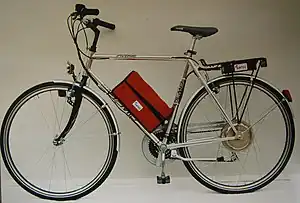
.jpg.webp)

| Part of a series on |
| Sustainable energy |
|---|
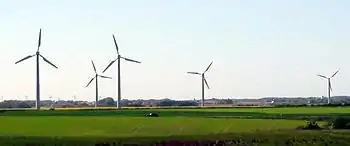 |
|
An electric bicycle (e-bike, eBike, etc.) is a motorized bicycle with an integrated electric motor used to assist propulsion.[2] Many kinds of e-bikes are available worldwide, but they generally fall into two broad categories: bikes that assist the rider's pedal-power (i.e. pedelecs) and bikes that add a throttle, integrating moped-style functionality. Both retain the ability to be pedaled by the rider and are therefore not electric motorcycles. E-bikes use rechargeable batteries and typically are motor-powered up to 25 to 32 km/h (16 to 20 mph). High-powered varieties can often travel more than 45 km/h (28 mph).
Depending on local laws, many e-bikes (e.g., pedelecs) are legally classified as bicycles rather than mopeds or motorcycles. This exempts them from the more stringent laws regarding the certification and operation of more powerful two-wheelers which are often classed as electric motorcycles, such as licensing and mandatory safety equipment. E-bikes can also be defined separately and treated under distinct electric bicycle laws. In UK legislation the vehicles are called electrically assisted pedal cycles (EAPC), in EU legislation electrically power assisted cycles (EPAC).[3]
History
1890s to 1980s
In the 1890s, electric bicycles were documented within various U.S. patents. For example, on 31 December 1895, Ogden Bolton Jr. was granted a patent for a battery-powered bicycle with "6-pole brush-and-commutator direct current (DC) hub motor mounted in the rear wheel" (U.S. Patent 552,271). There were no gears and the motor could draw up to 100 amperes from a 10-volt battery.[4]
Two years later, in 1897, Hosea W. Libbey of Boston invented an electric bicycle (U.S. Patent 596,272) that was propelled by a "double electric motor". The motor was designed within the hub of the crankset axle.[5] (This model was later re-invented and imitated in the late 1990s by Giant Lafree e-bikes.)
By 1898, a rear-wheel drive electric bicycle, which used a driving belt along the outside edge of the wheel, was patented by Mathew J. Steffens. An 1899 patent by John Schnepf (U.S. Patent 627,066) depicted an electric bicycle with a rear-wheel friction, "roller-wheel"-style drive.[6] In 1969, Schnepf's invention was expanded by G. A. Wood Jr. (U.S. Patent 3,431,994). Wood's device used four fractional horsepower motors connected through a series of gears.[7]
E-bikes since the 1980s
From 1992, Vector Services Limited offered the Zike e-bike.[8] The bicycle included NiCd batteries that were built into a frame member and included an 850 g permanent-magnet motor.
Torque sensors and power controls were developed during the late 1990s. For example, a Japanese patent (6163148) was granted in 1997 to a team led by Yutaka Takada,[9] for a "Sensor, drive force auxiliary device ... and torque sensor zero point adjusting mechanism".
American car executive Lee Iacocca founded EV Global Motors in 1997, a company that produced an electric bicycle model named E-bike SX, and it was one of the early efforts to popularize e-bikes in the US.[10]
By 2007, e-bikes were thought to make up 10 to 20 percent of all two-wheeled vehicles on the streets of many major Chinese cities.[11] A typical unit requires eight hours to charge the battery, which provides the range of 25 to 30 miles (40 to 48 km),[11] at the speed of around 20 km/h (12 mph).[12]
Gallery
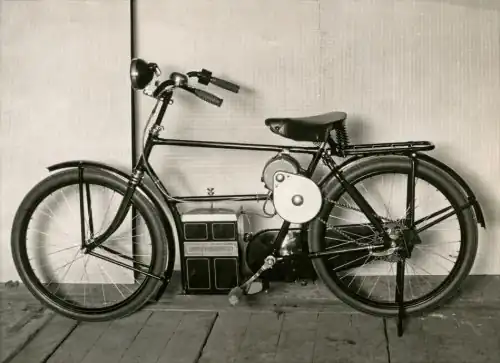 E-bike 1932 (by Philips & Simplex)
E-bike 1932 (by Philips & Simplex) A bike equipped with an after market electric hub motor conversion kit, with the battery pack placed on the rear carrier rack
A bike equipped with an after market electric hub motor conversion kit, with the battery pack placed on the rear carrier rack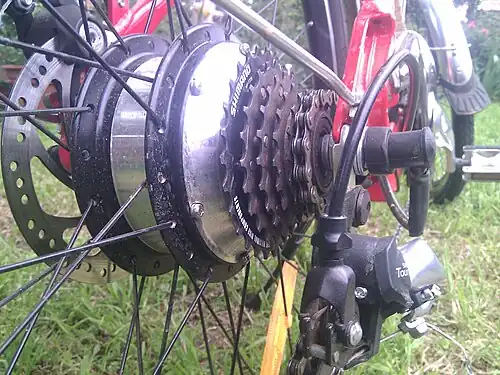 Brushless DC electric motor (BLDC) bicycle hub motor
Brushless DC electric motor (BLDC) bicycle hub motor
Classes
E-bikes are classed according to the power that their electric motor can deliver and the control system, i.e., when and how the power from the motor is applied. Also the classification of e-bikes is complicated as much of the definition is due to legal reasons of what constitutes a bicycle and what constitutes a moped or motorcycle. As such, the classification of these e-bikes varies greatly across countries and local jurisdictions.
Despite these legal complications, the classification of e-bikes is mainly decided by whether the e-bike's motor assists the rider using a pedal-assist system or by a power-on-demand one. Definitions of these are as follows:
- With pedal-assist, the electric motor is regulated by pedalling. The pedal-assist augments the efforts of the rider when they are pedalling. These e-bikes – called pedelecs – have a sensor to detect the pedalling speed, the pedalling force, or both. Brake activation is sensed to disable the motor as well.
- With power-on-demand, the motor is activated by a throttle, usually handlebar-mounted just like on most motorcycles or scooters.
Therefore, very broadly, e-bikes can be classed as:
- E-bikes with pedal-assist only: either pedelecs (legally classed as bicycles) or S-Pedelecs[13] (often legally classed as mopeds)
- Pedelecs: have pedal-assist only, motor assists only up to a decent but not excessive speed (usually 25 km/h or 16 mph), motor power up to 250 W (0.34 hp), often legally classed as bicycles
- S-Pedelecs: have pedal-assist only, motor power can be greater than 250 W (0.34 hp), can attain a higher speed (e.g., 45 km/h or 28 mph)) before motor stops assisting, sometimes legally classed as a moped or motorcycle.
- E-bikes with power-on-demand and pedal-assist
- E-bikes with power-on-demand only: often have more powerful motors than pedelecs but not always, the more powerful of these are legally classed as mopeds or motorcycles
Pedal-assist only
E-bikes with pedal-assist only are usually called pedelecs but can be broadly classified into pedelecs proper and the more powerful S-Pedelecs.
Pedelecs
The term "pedelec" (from pedal electric cycle) refers to a pedal-assist e-bike with a relatively low-powered electric motor and a decent but not excessive top speed. Pedelecs are legally classed as bicycles rather than low-powered motorcycles or mopeds.
The most influential definition of pedelecs comes from the EU. EU directive (EN15194 standard) for motor vehicles considers a bicycle to be a pedelec if:
- The pedal-assist, i.e. the motorised assistance that only engages when the rider is pedalling, cuts out once
- 25 km/h (16 mph) is reached, and
- when the motor produces maximum continuous rated power of not more than 250 W (0.34 hp) (n.b. the motor can produce more power for short periods, such as when the rider is struggling to get up a steep hill).
An e-bike conforming to these conditions is considered to be a pedelec in the EU and is legally classed as a bicycle. The EN15194 standard is valid across the whole of the EU and has been adopted by some non-EU European nations including the UK,[14] and also some non-European jurisdictions (such as the state of Victoria in Australia).[15]
Pedelecs are much like conventional bicycles in use and function—the electric motor only provides assistance, for example, when the rider is climbing or struggling against a headwind. Pedelecs are therefore especially useful for people in hilly areas where riding a bike would prove too strenuous for many to consider taking up cycling as a daily means of transport. They are also useful for riders who more generally need some assistance, e.g. for people with heart, leg muscle or knee joint issues.
S-Pedelecs
More powerful pedelecs which are not legally classed as bicycles are dubbed S-Pedelecs (short for Schnell-Pedelecs, i.e. Speedy-Pedelecs) in Germany. These have a motor more powerful than 250 W (0.34 hp) and less limited, or unlimited, pedal-assist, i.e. the motor does not stop assisting the rider once 25 km/h (16 mph) has been reached. S-Pedelec class e-bikes are therefore usually classified as mopeds or motorcycles rather than as bicycles and therefore may (depending on the jurisdiction) need to be registered and insured, the rider may need some sort of driver's license (either car or motorcycle) and motorcycle helmets may have to be worn.[16] In the United States, many states have adopted S-Pedelecs into the Class 3 category, limited to not more than 750 W (1.01 hp) of power and 28 mph (45 km/h) speed.[17] In Europe they are likely to be classed as mopeds requiring a registration plate and a licensed driver [18]
Power-on-demand and pedal-assist
Some newer electric bikes include a pedal assist system (PAS) with or without throttle, allowing riders to pedal while using the electric motor to increase range. There are electric propulsion conversion kits for ordinary bicycles.
Power-on-demand only
Some e-bikes have an electric motor that operates on a power-on-demand basis only; the motor is engaged and operated manually using a throttle, with control usually on the handgrip as on a motorbike or scooter. These sorts of e-bikes often, but not always, have more powerful motors than pedelecs.
With power-on-demand only e-bikes the rider can:
- ride by pedal power alone, i.e. fully human-powered.
- ride by electric motor alone by operating the throttle manually.
- ride using both together at the same time.
Some power-on-demand only e-bikes are very different from, and cannot be classified as, bicycles. For example, the Noped is a term used by the Ministry of Transportation of Ontario for e-bikes which are not fitted with pedals.
Legal status
| Country/jurisdiction | Type of e-bike | Speed limit, km/h | mph | Watt limit | Weight limit, kg | Age requirement | Demands license plates | Allowed on bike paths | References & footnotes |
|---|---|---|---|---|---|---|---|---|---|
| Australia | pedelec | 25 + 10% | 15.5 | 250 | none | none | no | yes |
ACT[19] NSW[20] NT[21] QLD[22] SA[23] Tas[24] Vic[25] WA[26] |
| Australia | hand-throttle or pedal-assist (some states specifically ban hand-throttle e-bikes) | none | none | 200 | none | none | no | yes |
ACT[19] NSW[20] NT[21] QLD[22] SA[23] Tas[24] Vic[25] WA[26] |
| Brazil | pedelec | 32 | 20 | 1000 | none | none | no | varies from municipal by-laws | [27] |
| Canada | hand-throttle | 32 | 20 | 500 | none | various | no | varies from municipal by-laws | [28] |
| China | both | 25 | 15.5 | 400 | 55 | 16 | no | yes | [29] |
| European Union and Norway | pedelec | 25 +10% | 15.5 | 250 | none | none | no | yes | [30] |
| Germany | pedelec | 25 | 15.5 | 250 | none | none | no | yes | [31][32] |
| Germany | s-pedelec | 45 | 28 | 4000 | none | 16 | insurance identifier plate | no | [31][32] |
| Norway | speed pedelec | 45 | 28 | 500 | none | none | no[33] | yes [34] | [35] |
| Hong Kong | none allowed | – | – | – | – | – | – | – | [36] (**) |
| Indonesia | both | 25 | 15.5 | – | – | 12 | no | yes | [37] |
| Israel | pedelec | 25 | 15.5 | 250 | 30 | 16 | no | yes | |
| Mexico | both | same as motorcycles | same as motorcycles | – | – | 15+[38] | yes | no | [39] |
| New Zealand | pedelec | none | none | 300 | none | none | no | yes | |
| Taiwan | both | 25 | 15.5 | None | 40 | none | no | yes | [40] |
| Turkey | pedelec | 25 | 15.5 | 250 | none | none | no | yes | [41] |
| United Kingdom | pedelec | 25 | 15.5 | 250 | none | 14 | no | yes | [42][43] |
| United States | hand-throttle | 32 | 20 | 750 | none | none | no | varies | (***) |
(*) Allowed on bike paths when electric systems are turned off
(**) E-bikes are illegal in this region
(***) Some regions have special regulations, see corresponding entry under Electric bicycle laws.
Gallery
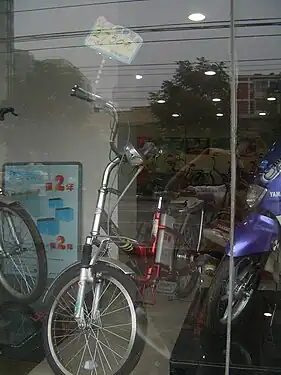 E-bikes and electric scooters in a specialized shop in Beijing in 2008. (Y2750 is around US$400.)
E-bikes and electric scooters in a specialized shop in Beijing in 2008. (Y2750 is around US$400.)
 Hybrid bicycle speedometer with integrated battery level measurement
Hybrid bicycle speedometer with integrated battery level measurement Yellow electric bike on West 54th Street
Yellow electric bike on West 54th Street.jpg.webp) e-Bikes in Split, Croatia
e-Bikes in Split, Croatia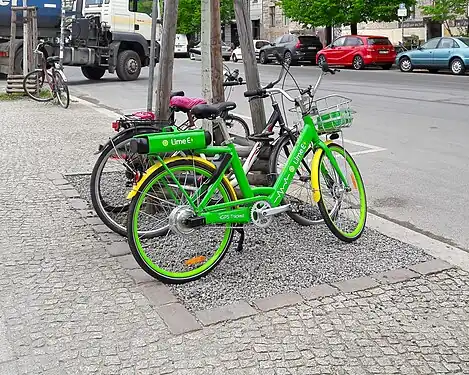 E-bikes in Berlin
E-bikes in Berlin
Popularity
E-bike usage worldwide has experienced rapid growth since 1998.[44]
China is the world's leading producer of e-bikes. According to the data of the China Bicycle Association, a government-chartered industry group, in 2004 China's manufacturers sold 7.5 million e-bikes nationwide, which was almost twice the year 2003 sales;[12] domestic sales reached 10 million in 2005, and 16 to 18 million in 2006.[11] In 2016, approximately 210 million electric bikes were used daily in China.[45]
According to trade umbrella body CONEBI, electric bike sales in the EU were over 5 million in 2021,[46] up from 2 million e-bikes in 2016,[45] up from 700,000 in 2010 and 200,000 in 2007.[47] In 2019, the EU implemented a 79.3% protective tariff on imported Chinese e-bikes to protect EU producers.[48] In 2022, electric bikes continued to grow market share in the EU, rising to 57% of bike sales in the Netherlands, 49% in Austria, 48% in Germany and 47% in Belgium.[49]
Technical
Motors and drivetrains
The two most common types of motors used in electric bicycles are brushed and brushless. Many configurations are available, varying in cost and complexity; direct-drive and geared motor units are both used. An electric power-assist system may be added to almost any pedal cycle using chain drive, belt drive, hub motors or friction drive. Brushless hub motors are the most common in modern designs. The motor is built into the wheel hub itself, while the stator is fixed solidly to the axle, and the magnets are attached to and rotating with the wheel. The bicycle wheel hub is the motor. The power levels of motors used are influenced by available legal categories and are often, but not always limited to under 750 watts. With a front-drive the motor sits in the front hub, and with a rear-drive the motor sits in the rear hub.
Another type of electric assist motor, often referred to as the mid-drive system, is increasing in popularity. With this system, the electric motor is not built into the wheel but is usually mounted near (often under) the bottom bracket shell. In more typical configurations, a cog or wheel on the motor drives a belt or chain that engages with a pulley or sprocket fixed to one of the arms of the bicycle's crankset. Thus, the propulsion is provided at the pedals rather than at the wheel, being eventually applied to the wheel via the bicycle's standard drive train. Freewheel crank, that is a freewheel in the bottom bracket, is a necessary part in mid-drive systems to allow the electric motor to work inside its optimal rotational speed range (r/min).
Because the power is applied through the chain and sprocket, power is typically limited to around 250–500 watts to protect against fast wear on the drivetrain. An electric mid-drive combined with an internal gear hub at the back hub may require care due to the lack of a clutch mechanism to soften the shock to the gears at the moment of re-engagement. A continuously variable transmission or a fully automatic internal gear hub may reduce the shocks due to the viscosity of oils used for liquid coupling instead of the mechanical couplings of the conventional internal gear hubs.[50]
The main advantage mid-drive motors have over hub motors is that power is applied through the chain (or belt) and thus it uses the existing rear gears (either external or internal). This allows for the motor to operate more efficiently at a wider range of vehicle speeds. Without using the bicycle's gears, equivalent hub motors tend to be less effective propelling the ebike slowly up steep hills and also propelling the ebike fast on the flat.
Batteries
E-bikes use rechargeable batteries in addition to electric motors and some form of control. Battery systems in use include sealed lead–acid (SLA), nickel–cadmium (NiCad), nickel–metal hydride (NiMH) or lithium-ion polymer (Li-ion). Batteries vary according to the voltage, total charge capacity (amp hours), weight, the number of charging cycles before performance degrades, and ability to handle over-voltage charging conditions. The energy costs of operating e-bikes are small, but there can be considerable battery replacement costs. The lifespan of a battery pack varies depending on the type of usage. Shallow discharge/recharge cycles will help extend the overall battery life.
Range is a key consideration with e-bikes, and is affected by factors such as motor efficiency, battery capacity, efficiency of the driving electronics, aerodynamics, hills and weight of the bike and rider.[51][52] Some manufacturers, such as the Canadian BionX or American Vintage Electric Bikes,[53] have the option of using regenerative braking, the motor acts as a generator to slow the bike down prior to the brake pads engaging.[54] This is useful for extending the range and the life of brake pads and wheel rims. There are also experiments using fuel cells. e.g. the PHB. Some experiments have also been undertaken with super capacitors to supplement or replace batteries for cars and some SUVS. E-bikes developed in Switzerland in the late 1980s for the Tour de Sol solar vehicle race came with solar charging stations but these were later fixed on roofs and connected so as to feed into the electric mains.[55] The bicycles were then charged from the mains, as is common today. While e-bike batteries were produced mainly by bigger companies in past, many small to medium companies have started using innovative new methods for creating more durable batteries. State of the art, custom built automated precision CNC spot welding machines[56] created 18650 battery packs[57] are commonly used among do-it-yourself e-bike makers.
Design variations
Not all e-bikes take the form of conventional push-bikes with an incorporated motor, such as the Cytronex bicycles which use a small battery disguised as a water bottle.[58][59] Some are designed to take the appearance of low capacity motorcycles, but smaller in size and consisting of an electric motor rather than a petrol engine. For example, the Sakura e-bike incorporates a 200 W motor found on standard e-bikes, but also includes plastic cladding, front and rear lights, and a speedometer. It is styled as a modern moped, and is often mistaken for one.
Converting a non-electric bicycle to its electric equivalent can be complicated but numerous 'replace a wheel' solutions are now available on the market.[60]
An Electric Pusher Trailer is an e-bike design which incorporates a motor and battery into a trailer that pushes any bicycle. One such trailer is the two-wheeled Ridekick. Other, rarer designs include that of a 'chopper' styled e-bike, which are designed as more of a 'fun' or 'novelty' e-bike than as a purposeful mobility aid or mode of transport.
Electric cargo bikes allow the rider to carry large, heavy items which would be difficult to transport without electric power supplementing the human power input.[61] These bikes can also allow for adults to continue biking into parenthood, enabling the transportation of children without using a car.[62]
There are many e-bikes design variations available, some with batteries attached to the frame, some housed within the tube. Some use fat tires for improved stability and off-road capability.[63]
Various designs (including those mentioned above) are designed to fit inside most area laws, and the ones that contain pedals can be used on roads in the United Kingdom, among other countries.[64]
Folding e-bikes are also available.[65]
Electric self-balancing unicycles do not conform to e-bike legislation in most countries and therefore cannot be used on the road,[66] but may be legal to use on the sidewalk. They are the cheapest electric cycles and used by the last mile commuters, for urban use and to be combined with public transport, including buses. They are not legal for use on the public highway (including footways and cycle paths) in the United Kingdom.[67]
Tricycles
Electric trikes have also been produced that conform to the e-bike legislation. These have the benefit of additional low speed stability and are often favored by people with disabilities. Cargo carrying tricycles are also gaining acceptance, with a small but growing number of couriers using them for package deliveries in city centres. Latest designs of these trikes resemble a cross-between a pedal cycle and a small van.[68]
 Diagram illustrating a standard bicycle converted to an e-bike using a retail conversion kit
Diagram illustrating a standard bicycle converted to an e-bike using a retail conversion kit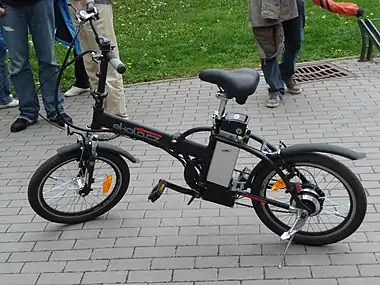 A folding e-bike
A folding e-bike A modern electric cargo trike in use in London, with a payload of up to 250 kg (550 lb)
A modern electric cargo trike in use in London, with a payload of up to 250 kg (550 lb)
Health effects
E-bike use was shown to increase the amount of physical activity. E-bike users in seven European cities had 10% higher weekly energy expenditure than other cyclists because they cycled longer trips.[69]
E-bikes can also provide a source of exercise for individuals who have trouble exercising for an extended time (due to injury or excessive weight, for example) as the bike can allow the rider to take short breaks from pedaling and also provide confidence to the rider that they'll be able to complete the selected path without becoming too fatigued[70] or without having forced their knee joints too hard (people who need to use their knee joints without wearing them out unnecessarily may in some electric bikes adjust the level of motor assistance according to the terrain). A University of Tennessee study provides evidence that energy expenditure (EE) and oxygen consumption (VO2) for e-bikes are 24% lower than that for conventional bicycles, and 64% lower than for walking. Further, the study notes that the difference between e-bikes and bicycles are most pronounced on the uphill segments.[71]
There are individuals who claim to have lost considerable amounts of weight by using an electric bike.[72] A recent prospective cohort study however found that people using e-bikes have a higher BMI than those using conventional bikes.[73] By making the biking terrain less of an issue, people who would not otherwise consider biking can use the electric assistance when needed and otherwise pedal as they are able.[74] E-bikes can be a useful part of cardiac rehabilitation programmes, since health professionals will often recommend a stationary bike be used in the early stages of these. Exercise-based cardiac rehabilitation programmes can reduce deaths in people with coronary heart disease by around 27%.[75]
Road traffic safety
Schleinitz et al. (2014) concluded that e-bike users in Germany were no more likely than conventional cyclists to be involved in "safety-critical situations". However, Dozza et al. (2015) concluded (from an analysis of Swedish cyclists) that e-bikers may be involved in more critical incidents but with "lower severity". Additionally, e-bikers were less likely to have dangerous interactions with motorized vehicles.[76]
Environmental effects
E-bikes are zero-emissions vehicles, as they emit no combustion by-products, but the environmental effects of electricity generation and power distribution and of manufacturing and recycling batteries[77] must be accounted for. E-bikes emit similar pollutants per kilometer as buses, with emission rates several times lower than motorcycles and cars.[78] Even with these issues considered, e-bikes have a significantly lower environmental impact than cars,[79] and are generally seen as environmentally desirable in an urban environment.[80][81]
A 2018 study in England found that e-bikes, if used to replace car travel, have the capability to "cut car carbon dioxide (CO2) emissions in England by up to 50% (about 30 million tonnes per year)".[82]
It has been suggested that the greatest opportunities are in rural and sub-urban settings: city dwellers already have many low-carbon travel options, so the greatest impact would be on encouraging use outside urban areas.[83] There may also be scope for e-bikes to help people who are most affected by rising transport costs.
The environmental effects involved in recharging the batteries can of course be reduced. The small size of the battery pack on an e-bike, relative to the larger pack used in an electric car, makes them very good candidates for charging via solar power or other renewable energy resources. Sanyo capitalized on this benefit when it set up "solar parking lots", in which e-bike riders can charge their vehicles while parked under photovoltaic panels.[84]
The environmental credentials of e-bikes, and electric / human powered hybrids generally, have led some municipal authorities to use them, such as Little Rock, Arkansas, with their Wavecrest electric power-assisted bicycles or Cloverdale, California police with Zap e-bikes. China's e-bike manufacturers, such as Xinri, are now partnering with universities in a bid to improve their technology in line with international environmental standards, backed by the Chinese government who is keen to improve the export potential of the Chinese manufactured e-bikes.[85]
Both land management regulators and mountain bike trail access advocates have argued for bans of electric bicycles on outdoor trails that are accessible to mountain bikes, citing potential safety hazards as well as the potential for electric bikes to damage trails. A study conducted by the International Mountain Bicycling Association, however, found that the physical impacts of low-powered pedal-assist electric mountain bikes may be similar to traditional mountain bikes.[86]
A recent study on the environment impact of e-bikes vs other forms of transportation[87] found that e-bikes are:
- 18 times more energy efficient than an SUV
- 13 times more energy efficient than a sedan
- 6 times more energy efficient than rail transit
- Of about equal impact to the environment as a conventional bicycle.
There are strict shipping regulations for lithium-ion batteries, due to safety concerns.[88] In this regard, lithium iron phosphate batteries are safer than lithium cobalt oxide batteries.[89]
Experience by country
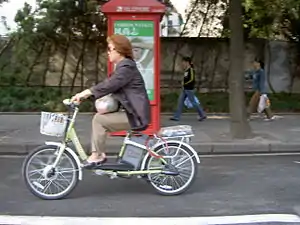 An e-bike in China. Here the rider is not using the pedals.
An e-bike in China. Here the rider is not using the pedals.
 A police pedelec in Tokyo
A police pedelec in Tokyo Delivery e-bike with license plate in Manhattan, New York City
Delivery e-bike with license plate in Manhattan, New York City
China
China has experienced an explosive growth of sales of non-assisted e-bikes including scooter type, with annual sales jumping from 56,000 units in 1998 to over 21 million in 2008,[90] and reaching an estimated fleet of 120 million e-bikes in early 2010.[44][91] This boom was triggered by Chinese local governments' efforts to restrict motorcycles in city centers to avoid traffic disruption and accidents. By late 2009 motorcycles are banned or restricted in over ninety major Chinese cities.[90] Users began replacing traditional bicycles and motorcycles and e-bike became an alternative to commuting by car.[44] Nevertheless, road safety concerns continue as around 2,500 e-bike related deaths were registered in 2007.[91] By late 2009 ten cities had also banned or imposed restrictions on e-bikes on the same grounds as motorcycles. Among these cities were Guangzhou, Shenzhen, Changsha, Foshan, Changzhou, and Dongguang.[90][91]
In April 2019, the China's regulatory policies change, new standards around electric bikes were introduced, governing things like a bicycle's weight, maximum speed and nominal voltage.[92] Vehicles which apply the new standard, including international 25 km/h speed limit, are legally considered as bicycles and do not require registration. E-bikes out of this standard are considered as motorcycles subject to helmet and license regulation.[93]
China is the world's leading manufacturer of e-bikes, with 22.2 million units produced in 2009. Some of the biggest manufacturers of E-bikes in the world are BYD and Geoby. Production is concentrated in five regions, Tianjin, Zhejiang, Jiangsu, Shandong, and Shanghai.[94] China exported 370,000 e-bikes in 2009.[95] In 2019, about 223,000 China companies were in businesses related to the electric-bike industry.[92]
Netherlands
The Netherlands has a fleet of 18 million bicycles.[96] E-bikes have reached a market share of 10% by 2009, as e-bikes sales quadrupled from 40,000 units to 153,000 between 2006 and 2009,[97] and the electric-powered models represented 25% of the total bicycle sales revenue in that year.[96] By early 2010 one in every eight bicycles sold in the country is electric-powered despite the fact that on average an e-bike is three times more expensive than a regular bicycle.[91][97] E-bike sales have now overtaken those of unpowered bikes, reaching 423,000 in 2019 and 547,000 in 2020.
A 2008 market survey showed that the average distance traveled in the Netherlands by commuters on a standard bicycle is 6.3 kilometres (3.9 mi) while with an e-bike this distance increases to 9.8 kilometres (6.1 mi).[98] This survey also showed that e-bike ownership is particularly popular among people aged 65 and over, but limited among commuters. The e-bike is used in particular for recreational bicycle trips, shopping and errands.[98]
United States
In 2009 the U.S. had an estimated fleet of 200,000 e-bikes.[95] In 2012 they were increasingly favored in New York as food-delivery vehicles.[99] The North American Electric Bike Market is expected to grow at a CAGR of 10.13% from 2021 to 2028.[100]
India
In India electric bicycles market was valued at US$1.14 million in 2021, and is expected to reach US$2.31 million by 2027, projecting a CAGR of 12.69% during this forecast period.[101]
Use in warfare
Ukraine is using e-bikes for the war against Russia. These donated bikes are used for snipers and anti-tank weapons.[102] This echoes past usage of bicycle infantry in wartime, particularly by the Japanese forces.[103]
See also
References
- ↑ "The nCycle is Here". Yanko Design. 29 August 2014. Retrieved 2020-08-30.
- ↑ Stilo, Lorenzo; Segura-Velandia, Diana; Lugo, Heinz; Conway, Paul P.; West, Andrew A. (2021). "Electric bicycles, next generation low carbon transport systems: A survey". Transportation Research Interdisciplinary Perspectives. 10: 100347. doi:10.1016/j.trip.2021.100347.
- ↑ "Guide to e-bikes". Association of Cycle Traders. Accessed May 1, 2022.
- ↑ "Electrical bicycle". Retrieved April 9, 2020.
- ↑ "Electric bicycle". Retrieved April 9, 2020.
- ↑ "schnepf". Retrieved April 9, 2020.
- ↑ "Electric drive for bicycles". Retrieved April 9, 2020.
- ↑ "Electric Bikes". Zike Bike Spares & Sales. Archived from the original on 2009-04-24. Retrieved 2009-08-31.
- ↑ "US Patent for Sensor, drive force auxiliary device using the sensor, and torque sensor zero point adjusting mechanism of the drive force auxiliary device Patent (Patent # 6,163,148 issued December 19, 2000) - Justia Patents Search".
- ↑ Tergesen, Anne (1997-09-21). "INVESTING IT; A Bet on Electric Bikes, or at Least on Lee Iacocca". The New York Times.
- 1 2 3 "Cheap and green, electric bikes are the rage in China" Archived 2013-01-12 at archive.today, by Tim Johnson. Originally published 23 May 2007 by McClatchy Newspapers.
- 1 2 "China's Cyclists Take Charge", By Peter Fairley. IEEE Spectrum, June 2005
- ↑ "Characteristics of Pedelecs and S-Pedelecs". November 2012.
- ↑ Seddon, Sean (9 June 2023). "E-bikes: What is the law and is there an age limit?". BBC News.
- ↑ "Power assisted bicycles". VicRoads website. VicRoads. Archived from the original on 28 March 2013. Retrieved 25 August 2013.
- ↑ "Was Sie über den Versicherungsschutz von pedelecs wissen sollten" (in German). Gesamtverband der Deutschen Versicherungswirtschaft (German Insurance Association). Retrieved 21 March 2013.
- ↑ "What Are Electric Bike Classes and Why do They Matter?". 28 April 2018.
- ↑ Stromer SA:When people say e-bike, they usually mean a Pedelec – or an S-Pedelec.
- 1 2 "Australian Capital Territory Government Road Transport (General) Amendment Act 2013" (PDF). Retrieved 26 November 2016.
- 1 2 "New South Wales Government Roads and Maritime Services Vehicle standards information: Mopeds and power-assisted pedal cycles" (PDF). 8 December 2014. Retrieved 26 November 2016.
- 1 2 "Northern Territory Government Department of Transport: V56 – Motorised Foot Scooters and Power-assisted Cycles" (PDF). 20 November 2015. Retrieved 26 November 2016.
- 1 2 "Queensland Government: Bicycle road rules and safety". Retrieved 26 November 2016.
- 1 2 "Government of South Australia: Riding a power-assisted bicycle". Retrieved 26 November 2016.
- 1 2 "Tasmanian Government Information Sheet: Power-assisted Pedal Cycles". November 2016. Retrieved 26 November 2016.
- 1 2 "Vicroads: Power assisted bicycles". Retrieved 26 November 2016.
- 1 2 "Government of Western Australia: Bicycle rules, standards and safety". Retrieved 26 November 2016.
- ↑ BRASIL, Conselho Nacional de Trânsito (CONTRAN). Resolução no 966, de 15 de junho de 2023
- ↑ "Canadian Electric Bike Rules and Regulations". EBIKEBC. Retrieved 2023-01-30.
- ↑ "《电动自行车安全技术规范》(GB17761-2018)国家标准解读". gxt.nmg.gov.cn. Retrieved 2022-08-02.
- ↑ European standard NF EN 15194 for Electrically power assisted cycles Archived 2012-12-24 at the Wayback Machine section 4.2.6.1 Requirements: The maximum [assisted] speed [is] 25 km/h (…) During a production conformity check, the maximum speed may differ by ± 10% from the above-mentioned determined value.
- 1 2 "Gesetzliche Regelungen für E-Bike und Pedelec - ingenieur.de". ingenieur.de - Jobbörse und Nachrichtenportal für Ingenieure (in German). 2019-05-06. Retrieved 2020-10-20.
- 1 2 "Rechte und Gesetze rund ums Thema E-Bike: Alles Wissenswerte". RADfahren.de (in German). 2019-05-17. Retrieved 2020-10-20.
- ↑ "Forskrift om bruk av kjøretøy - Kapittel 2. Registrering - Lovdata". lovdata.no. Retrieved 2023-09-11.
- ↑ miljødepartementet, Klima-og (2018-11-09). "Prop. 11 L (2018–2019)". Regjeringen.no (in Norwegian). Retrieved 2023-09-11.
- ↑ Article on speed pedelec in Norway (in Norwegian)
- ↑ "Transport Department, Hong Kong SAR Government" (PDF). Retrieved Apr 9, 2020.
- ↑ "Permenhub No. 45 Tahun 2020". Database Peraturan | JDIH BPK. Retrieved 2023-09-26.
- ↑ "Permiso de conducir para menores de edad" (in Spanish). Archived from the original on 2015-12-22.
- ↑ "Reglamento de tránsito de la Ciudad de México" (PDF) (in Spanish). Archived from the original (PDF) on 2015-11-24.
- ↑ "電動輔助自行車及電動自行車介紹與法規修訂說明" (PDF). Retrieved Apr 16, 2020.
- ↑ "Bi̇si̇klet Yolları Yönetmeli̇ği̇" [Bicycle path regulations]. Official Gazette. 12 December 2019.
- ↑ "Electric bikes: licensing, tax and insurance". GOV.UK. Retrieved Apr 9, 2020.
- ↑ Rear, Jack; Davies, Paul; Morrissy-Swan, Tomé; Cooper, Jonny; Howell, Madeleine (2020-05-28). "The best e-bikes to get around on after lockdown: tried and tested". The Telegraph. ISSN 0307-1235. Archived from the original on 2022-01-12. Retrieved 2020-05-29.
- 1 2 3 4 J. David Goodman (2010-01-31). "An Electric Boost for Bicyclists". The New York Times. Retrieved 2010-05-31.
- 1 2 Black, Forbes. "The State of the Electric Bicycle Market", Electricbikereport.com, September 19, 2016
- ↑ "European electric bike sales pass 5 million, all bikes 22 million". 7 July 2022.
- ↑ "Europe's E-Bike Imports Indicate Market Size". Bike Europe. 2013-08-05.
- ↑ "European Commission imposes up to 79.3% combined anti-dumping and anti-subsidy duties on e-bike imports from China". CNBC. Jan 18, 2019.
- ↑ "E-bike sales thrives, amidst market slowdown in Europe". www.bike-eu.com. 2023-04-28. Retrieved 2023-06-26.
- ↑ https://pinion.eu/en/technology/
- ↑ "Electric bike trip simulator". Retrieved 2013-05-25.
- ↑ "Electric Bicycle Range"; Electric Bicycle Guide (retrieved 2014-03-09)
- ↑ "The Fastest Electric Bike | Vintage Electric Bikes".
- ↑ "BionX FAQ Page". Archived from the original on 2010-03-22. Retrieved 2010-03-19.
- ↑ Technisches "Reglement der Tour de Sol 1989/1990", published by Tour de Sol, Bern, Switzerland
- ↑ "EM3EV battery factory tour - State of the art 18650 battery packs". YouTube. 2017-06-09. Archived from the original on 2021-11-17. Retrieved 2020-04-09.
- ↑ "EBike battery, motors and Electric Bike kits | EM3ev".
- ↑ Henshaw, Peter (2008-09-05). "Cytronex Trek FX: A bike with boost". The Telegraph. Archived from the original on 2008-10-06.
- ↑ Peace, Richard (2008-08-26). "Electric bikes start to come of age". Future Publishing.
- ↑ "Tron-inspired electric bike wheel chucks the hub". www.gizmag.com. 2 May 2016. Retrieved 2016-06-02.
- ↑ "Electric Cargo Bike Guide". Electric Bike Report. 2010-09-01. Retrieved 2010-10-06.
- ↑ Thomas, Alainna (2022-07-01). "Electric bicycles and cargo bikes—Tools for parents to keep on biking in auto-centric communities? Findings from a US metropolitan area". International Journal of Sustainable Transportation. 16 (7): 637–646. Bibcode:2022IJSTr..16..637T. doi:10.1080/15568318.2021.1914787. ISSN 1556-8318. S2CID 235549536.
- ↑ "Enter The Rapid Development Fat Tire E-bike In 2022". Electric Bike Blog - Addmotor. Retrieved 2022-03-17.
- ↑ "Electric Bike Sizing Guide". Electride. 2020-07-20. Retrieved 2021-06-02.
- ↑ Sutton, Mark (January 6, 2012). "EBCO introduces Solex electric bikes to the UK". Bike Biz. Retrieved 10 January 2012.
- ↑ Electric Unicycle by Amanda Kooser, May 18, 2011, cnet.com
- ↑ Department for Transport; Driver & Vehicle Standards Agency (December 2018). "Powered transporters". GOV.UK. United Kingdom. Retrieved 14 November 2022.
It is illegal to use a powered transporter: on a public road without complying with a number of legal requirements, which potential users will find very difficult[;] in spaces that are set aside for use by pedestrians, cyclists, and horse-riders; this includes on the pavement and in cycle lanes[.] Any person who uses a powered transporter on a public road or other prohibited space in breach of the law is committing a criminal offence and can be prosecuted. ... The term 'powered transporters' ... includes ... powered unicycles, and u-wheels.
- ↑ "Electric Delivery Trikes – will they catch on in Britain?". ITV Central News. 2013-11-20.
- ↑ Castro, A (2019). "Physical activity of electric bicycle users compared to conventional bicycle users and non-cyclists: Insights based on health and transport data from an online survey in seven European cities". Transportation Research Interdisciplinary Perspectives. 1: 100017. doi:10.1016/j.trip.2019.100017. hdl:10044/1/77527.
- ↑ "Why You Need an Electric Bike". MensFitness.com. 19 July 2013. Retrieved 2015-12-15.
- ↑ Langford, Brian Casey (2017). "Comparing physical activity of pedal-assist electric bikes with walking and conventional bicycles" (PDF).
- ↑ "Woman's Dramatic 280-pound Weight Loss". ABC News. 2014-12-03. Retrieved 2015-12-15.
- ↑ Dons, E (2018). "Transport mode choice and body mass index: Cross-sectional and longitudinal evidence from a European-wide study" (PDF). Environment International. 119 (119): 109–116. doi:10.1016/j.envint.2018.06.023. hdl:10044/1/61061. PMID 29957352. S2CID 49607716.
- ↑ "Pedego Electric Bike Makes Exercise Look and Feel Easy". Newsweek. 2015-04-11. Retrieved 2015-12-15.
- ↑ "Exercise – Rehabilitation – NHS Choices". Nhs.uk. 2010-01-25. Retrieved 2010-10-06.
- ↑ Haustein, Sonja; Møller, Mette (September 2016). "E-bike safety: Individual-level factors and incident characteristics". Journal of Transport & Health. 3 (3): 386–394. doi:10.1016/j.jth.2016.07.001. S2CID 54224506. Retrieved 6 October 2020.
- ↑ Gerow, Brian (2020-08-10). "How Sustainable are the Batteries in E-bikes and Other MTB Gadgets? We Asked a Battery Expert". Singletracks Mountain Bike News. Retrieved 2020-12-30.
- ↑ Cherry, Christopher R.; Weinert, Jonathan X.; Xinmiao, Yang (2009). "Comparative environmental impacts of electric bikes in China". Transportation Research Part D: Transport and Environment. 14 (5): 281–290. doi:10.1016/j.trd.2008.11.003. S2CID 54579197.
- ↑ Brand, Christian; Götschi, Thomas; Dons, Evi; Gerike, Regine; Anaya-Boig, Esther; Avila-Palencia, Ione; de Nazelle, Audrey; Gascon, Mireia; Gaupp-Berghausen, Mailin; Iacorossi, Francesco; Kahlmeier, Sonja (2021-03-01). "The climate change mitigation impacts of active travel: Evidence from a longitudinal panel study in seven European cities". Global Environmental Change. 67: 102224. doi:10.1016/j.gloenvcha.2021.102224. hdl:10044/1/89043. ISSN 0959-3780.
- ↑ Fishman, Elliot; Cherry, Christopher (30 Jul 2015). "E-bikes in the Mainstream: Reviewing a Decade of Research". Transport Reviews. Taylor & Francis Online. 36 (1): 72–91. doi:10.1080/01441647.2015.1069907. S2CID 155112620.
- ↑ Philips, Ian; Anable, Jillian; Chatterton, Tim (2022). "E-bikes and their capability to reduce car CO2 emissions". Transport Policy. 116: 11–23. doi:10.1016/j.tranpol.2021.11.019.
- ↑ Philips, Ian; Watling, David; Timms, Paul (2018-05-28). "Estimating individual physical capability (IPC) to make journeys by bicycle". International Journal of Sustainable Transportation. 12 (5): 324–340. Bibcode:2018IJSTr..12..324P. doi:10.1080/15568318.2017.1368748. ISSN 1556-8318.
- ↑ Philips, I., Anable, J., and Chatterton, T. 2020. "e-bike carbon savings – how much and where?" CREDS Policy brief 011. Oxford: Centre for Research into Energy Demand Solutions.
- ↑ Eaton, Kit (March 16, 2010). "Sanyo's Solar Bike Sheds—Green Power, Healthy and Clever". Fast Company. Retrieved 2010-03-19.
- ↑ "Electric Bicycles; the Green Innovation gaining traction in world export markets". Articlesbase.com. Retrieved 2010-10-06.
- ↑ Newland, Cameron (September 24, 2015). "IMBA Preliminary Study Results Suggest That Electric Bikes Aren't Especially Damaging To Mountain Bike Trails". Overvolted Electric Bike News and Reviews. Retrieved 2015-09-25.
- ↑ Shreya, Dave (February 2010). "Life Cycle Assessment of Transportation Options for Commuters" (PDF). Massachusetts Institute of Technology. Archived from the original (PDF) on 2011-07-15.
- ↑ "Lithium Battery Transport Information". Portable Rechargeable Battery Association. Retrieved December 14, 2022.
- ↑ Jacoby, Mitch (February 11, 2013). "Assessing The Safety Of Lithium-Ion Batteries". Chemical & Engineering News. Vol. 91, no. 6. American Chemical Society. Retrieved 14 December 2022.
- 1 2 3 Chi-Jen Yang (2010). "Launching strategy for electric vehicles: Lessons from China and Taiwan" (PDF). Technological Forecasting and Social Change (77): 831–834. Archived from the original (PDF) on 2010-03-31.
- 1 2 3 4 "China's electric-bicycle boom – Pedals of fire". The Economist. 2010-05-13. Retrieved 2010-05-31.
- 1 2 "E-Bikes Rule China's Urban Streets: Hyperdrive Daily". Bloomberg. 5 April 2021. Retrieved 2022-03-17.
- ↑ Global status report on road safety 2018. Geneva: World Health Organization; 2018. Licence: CC BY-NC-SA 3.0 IGO
- ↑ "China Remains World's Leading Electric Bicycle Manufacturer". EV World. 2005-05-28. Archived from the original on 2010-06-14. Retrieved 2010-06-01.
- 1 2 "China switches to e-bikes". Asia Times. 2010-05-07. Archived from the original on 2010-05-09. Retrieved 2010-06-01.
{{cite news}}: CS1 maint: unfit URL (link) - 1 2 "Netherlands bicycle capital of the world". Dutch Daily News. 2010-01-26. Retrieved 2010-05-31.
- 1 2 "In Holland One out of Eight Bikes Is Electric". Bike Europe. 2010-04-18. Retrieved 26 November 2016.
- 1 2 Hendriksen, Ingrid; et al. (2008). "Electric bicycles – market research and investigation". Fiets Beraad. Retrieved 2010-05-31.
- ↑ David Goodman, J. (March 2, 2012). "Food deliverymen on wheels". The New York Times.
- ↑ ltd, Research and Markets. "North America E-Bike Market 2021-2028 - Research and Markets". www.researchandmarkets.com. Retrieved 2022-03-17.
- ↑ "India E-bike Market Size, Share (2022 - 27) | Industry Analysis". www.mordorintelligence.com. Retrieved 2022-06-29.
- ↑ Gault, Matthew (24 May 2022). "Ukraine Is Using Quiet Electric Bikes to Haul Anti-Tank Weapons". Vice. Retrieved 14 December 2022.
- ↑ Mizokami, Kyle (19 May 2022). "Are Military E-Bikes the Next Big Thing in Land Warfare?". Popular Mechanics. Retrieved 14 December 2022.
External links
 Media related to Electrically powered bicycles at Wikimedia Commons
Media related to Electrically powered bicycles at Wikimedia Commons

